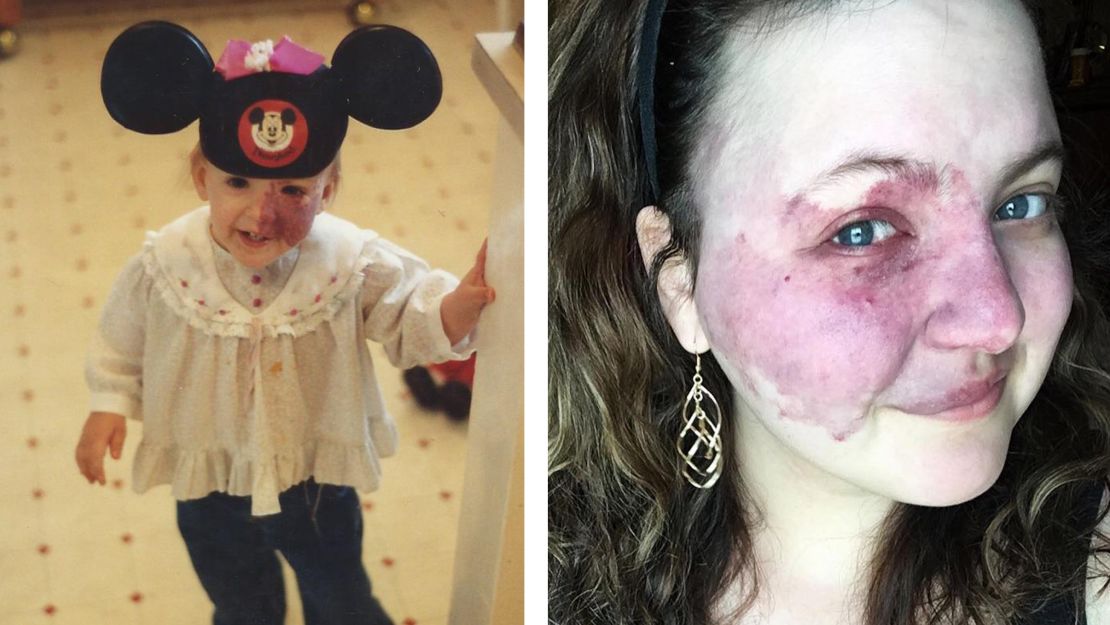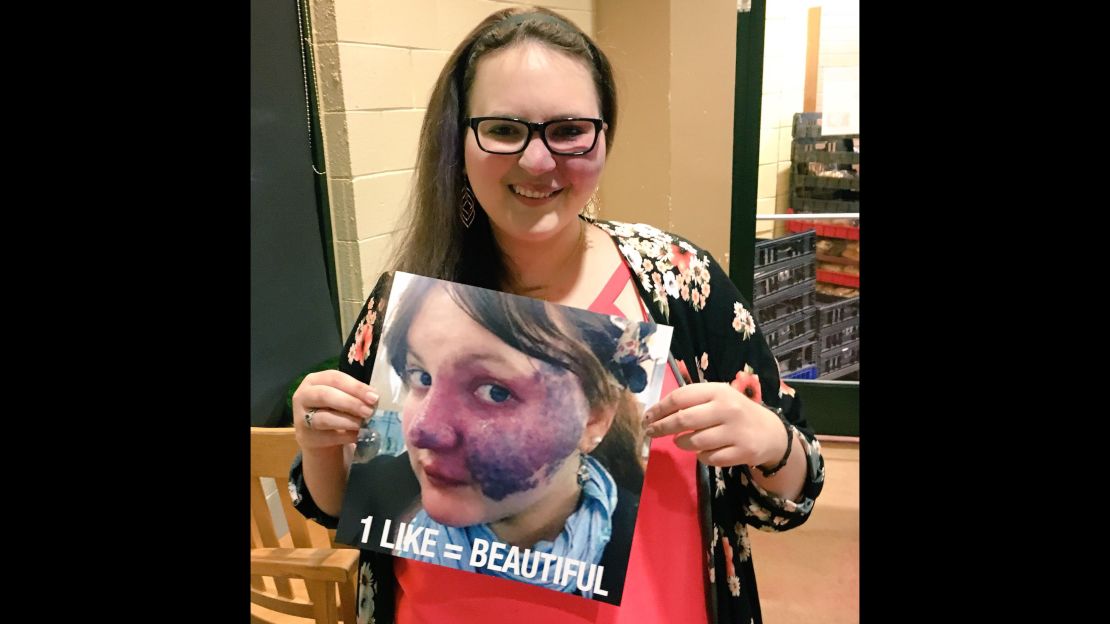Story highlights
Films tend to use skin findings to connote evil in villains, according to an analysis by dermatologists
This may increase prejudice and stigma toward people living with similar skin conditions
The first thing people tend to notice about Crystal Hodges is her birthmark: a red and purple patch, called a port-wine stain, that covers the left side of her face. As a child, a bully likened her to a notorious Batman villain.
“The name Two-Face is like nails on a chalkboard to my ears,” she wrote on The Mighty, which publishes stories by people living with health conditions and disabilities. Hodges is an editor there.
Most of the movie characters who come to mind who have distinctive facial features like she does, she recalled, are villains. And a new report, published today in the journal JAMA Dermatology, illustrates what she’s been saying all along.
Beyond movie villains, she told CNN, “we’re not represented in media or in books. We’re kind of left out.”

For the new study, a team of dermatologists examined a handful of the top villains and heroes as ranked by the American Film Institute. Among the villains, they found a cluster of dark circles, abnormal skin colors, scars and warts.
The trend goes back to the silent films of the early 1900s, when filmmakers relied on visual cues to show good and evil, according to the authors. The title vampire in the 1921 film “Nosferatu,” for example, features a ghastly pale, hairless antagonist.
But the trend continues today, the authors said, especially in a global cinema that relies heavily on established motifs.
“They’ll play scary music, and here you’ve got an image of a Bond villain or Freddy Krueger or Darth Vader that actually works internationally,” said San Francisco dermatologist Dr. Vail Reese, one of the study’s authors.
Among the film institute’s top villains were “Star Wars’ ” Darth Vader and Regan MacNeil from “The Exorcist,” both of whom have facial scars, abnormal skin color and deep, dark circles around their eyes. In her elderly form, the queen from “Snow White and the Seven Dwarfs” has deep wrinkles and a wart on her unusually large, reddish nose, a condition known as rhinophyma. Even the Wicked Witch of the West, in addition to her green complexion, has a wart on her chin.
The problem, Reese said, is that these portrayals impact, at least subconsciously, the way the public views real people living with differences that are only skin-deep.
“If you have families across the country and their only encounter with someone who’s albino was … seeing this evil scary character, what happens when at the mall they see somebody with albinism?” asked Reese, whose website Skinema.com follows skin conditions in movies such as Leonardo DiCaprio’s chapped lips in “The Revenant” and a young Ice Cube’s missing moles in “Straight Outta Compton.”
There are exceptions on both sides of the American Film Institute list, Reese said. These include the clear-faced Norman Bates from “Psycho” and Tom Hanks’ purple lesions in “Philadelphia” – a skin condition known as Kaposi’s sarcoma that is associated with AIDS. Even Hugh Jackman, of “Wolverine” fame, has brought attention to his real-life dealings with skin cancer. But these are only exceptions to the rule, Reese said.
“If we continue to pair a particular look with (being a villain) … then pretty soon, it’s like Pavlov’s dog: Simply seeing a person in that category is enough to prime thoughts of ‘villain,’ ” said Mary Beth Oliver, a professor at Penn State University and co-director of its Media Effects Research Laboratory. She added that the same types of associations can happen with race and ethnicity.
Oliver was not involved in the study, though she does conduct her own research on psychology and the media. Her latest work, yet unpublished, focuses on the “House of Cards” antihero Frank Underwood, played by Kevin Spacey. The project explores how people “have come to love Frank Underwood even if they know he’s immoral,” she said.
But given the findings of Reese’s analysis, she wondered, “Would we love Frank Underwood if he were physically repulsive?”
The struggles of self-image
Hodges is used to people’s curiosity about her birthmark, but she was not prepared for her own photo to go viral. Nearly three years ago, she received an alarming message from a friend in another state.
“Hey, I saw your picture on my newsfeed today,” the friend told her.
Someone had created a meme out of a photo Hodges had taken shortly after a laser treatment on the birthmark. It was reposted a number of times and seen by millions of people, she said. Because of the meme, people began to recognize her at stores and restaurants.

“It never dawned on me how different I must look until that happened,” Hodges said. “There’s always going to be an ounce of my heart that’s kind of broken from that experience.”
But rather than back away from the unwanted attention, Hodges saw it as an opportunity. She began writing blog posts and giving talks about her experience growing up looking different – and the responses poured in.
“There are a lot of women I’ve heard from who, their husbands have made them wear makeup to bed,” Hodges said.
She credits her parents, who “treated (her) like any other kid,” for giving her the confidence to wear her birthmark proudly in public.
But not all people with birthmarks, scars and other facial traits have thrived like she has. Skin conditions such as acne and alopecia, or hair loss, have been associated with mental health issues like anxiety and depression, according to Dr. Julie Amthor Croley, one of the study’s authors and a dermatology resident at the University of Texas Medical Branch.
“I think it certainly perpetuates the negative self-image that some of them harbor,” said Croley.
Playing the part
Dennis Hurley doesn’t just have a skin condition; he’s in the acting business. And he said it affects the callbacks he gets.
“I’ve auditioned for many, many serial killer roles,” he said.
Hurley is albino, a condition that affects the cells that produce pigment in his skin, hair and eyes. People with albinism typically have very pale skin and white hair.

“I feel like people with the skin condition that I have have been classified as … the butt of a joke or the scary albino,” Hurley said, referring to characters like Whitey from the comedy “Me, Myself and Irene” and the twin henchmen from “The Matrix Reloaded.”
Hurley captured the attention of multiple news networks with his parody of “The Da Vinci Code,” whose villain, Silas, is also albino. The film sparked outrage among the albino community, with the National Organization for Albinism and Hypopigmentation taking a public stance against the film.
Although Hurley originally submitted for that role, he said he was not tall enough to audition. The part eventually went to Paul Bettany, who is not albino.
“That’s a role that I could’ve done without makeup,” Hurley said.
One role that didn’t hinge upon his albinism, though, was his part as the grocery store worker in the music video for Justin Timberlake’s “Can’t Stop the Feeling.”
“The fact that I was in the Justin Timberlake video was pretty amazing.” he said. “They hired me on my dancing skills alone.”
Flipping the script
Many movie villains physically transform to match what’s on the inside, Reese said. Dr. Evil’s son, played by Seth Green in the “Austin Powers” movies, loses his hair as his behavior becomes more and more nefarious, matching his father. Linda Blair’s demonically possessed character in “The Exorcist” also undergoes a physical transformation.
“Before she’s possessed, she’s this fair-skinned redhead,” Reese said. “Not only does the devil take her over, cause her to vomit and twist her head around … but she gets these incredible scars and lacerations, and her skin color changes.”
Join the conversation
“It’s the whole idea that the skin lesions reflect the evil within an individual,” he added.
Hodges acknowledges that people often conflate inside and out, adding stigma to those who look different.
“I think it’s sad that we feel that we have to hide … because society says it’s not normal or healthy,” she said.

But Hodges decided that she would do exactly the opposite: She would become as visible as possible and set a positive example.
In an effort to embrace her appearance last year, Hodges invited 50 artists to draw her in their own styles. She was depicted as a Lego character, a mermaid, a Disney princess and a superhero. Many of the drawings prominently feature her birthmark, which is caused by an overgrowth of capillaries in the skin.
She hoped the images would encourage people like her. “I wanted them to see, if we were (in movies), here’s what we would look like,” she said.











